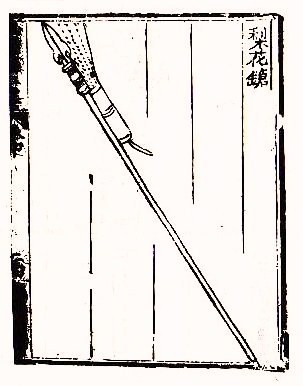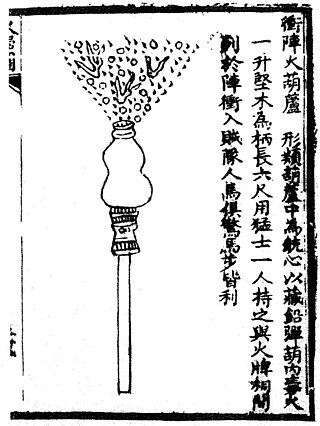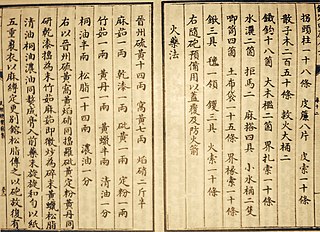A cannon is a large-caliber gun classified as a type of artillery, which usually launches a projectile using explosive chemical propellant. Gunpowder was the primary propellant before the invention of smokeless powder during the late 19th century. Cannons vary in gauge, effective range, mobility, rate of fire, angle of fire and firepower; different forms of cannon combine and balance these attributes in varying degrees, depending on their intended use on the battlefield. A cannon is a type of heavy artillery weapon.

A firearm is any type of gun that uses an explosive charge and is designed to be readily carried and operated by an individual. The term is legally defined further in different countries.
Gun laws and policies, collectively referred to as firearms regulation or gun control, regulate the manufacture, sale, transfer, possession, modification, and use of small arms by civilians. Laws of some countries may afford civilians a right to keep and bear arms, and have more liberal gun laws than neighboring jurisdictions. Gun control typically restricts access to certain categories of firearms and limits the categories of persons who may be granted permission to access firearms. There may be separate licenses for hunting, sport shooting, self-defense, collecting, and concealed carry, each with different sets of requirements, privileges, and responsibilities.

Gunpowder, also commonly known as black powder to distinguish it from modern smokeless powder, is the earliest known chemical explosive. It consists of a mixture of sulfur, charcoal, and potassium nitrate (saltpeter). The sulfur and charcoal act as fuels while the saltpeter is an oxidizer. Gunpowder has been widely used as a propellant in firearms, artillery, rocketry, and pyrotechnics, including use as a blasting agent for explosives in quarrying, mining, building pipelines, tunnels, and roads.

A weapon, arm, or armament is any implement or device that is used to deter, threaten, inflict physical damage, harm, or kill. Weapons are used to increase the efficacy and efficiency of activities such as hunting, crime, law enforcement, self-defense, warfare, or suicide. In a broader context, weapons may be construed to include anything used to gain a tactical, strategic, material, or mental advantage over an adversary or enemy target.

A projectile is an object that is propelled by the application of an external force and then moves freely under the influence of gravity and air resistance. Although any objects in motion through space are projectiles, they are commonly found in warfare and sports.

An arquebus is a form of long gun that appeared in Europe and the Ottoman Empire during the 15th century. An infantryman armed with an arquebus is called an arquebusier.

A musket is a muzzle-loaded long gun that appeared as a smoothbore weapon in the early 16th century, at first as a heavier variant of the arquebus, capable of penetrating plate armour. By the mid-16th century, this type of musket gradually disappeared as the use of heavy armour declined, but musket continued as the generic term for smoothbore long guns until the mid-19th century. In turn, this style of musket was retired in the 19th century when rifled muskets using the Minié ball became common. The development of breech-loading firearms using self-contained cartridges and the first reliable repeating rifles produced by Winchester Repeating Arms Company in 1860 also led to their demise. By the time that repeating rifles became common, they were known as simply "rifles", ending the era of the musket.

A grenade launcher is a weapon that fires a specially designed, large-caliber projectile, often with an explosive, smoke, or gas warhead. Today, the term generally refers to a class of dedicated firearms firing unitary grenade cartridges. The most common type are man-portable, shoulder-fired weapons issued to individuals, although larger crew-served launchers are issued at higher levels of organization by military forces.

A ranged weapon is any weapon that can engage targets beyond hand-to-hand distance, i.e. at distances greater than the physical reach of the user holding the weapon itself. The act of using such a weapon is also known as shooting. It is sometimes also called projectile weapon or missile weapon because it typically works by launching solid projectiles ("missiles"), though technically a fluid-projector and a directed-energy weapon are also ranged weapons. In contrast, a weapon intended to be used in hand-to-hand combat is called a melee weapon.

The hand cannon, also known as the gonne or handgonne, is the first true firearm and the successor of the fire lance. It is the oldest type of small arms, as well as the most mechanically simple form of metal barrel firearms. Unlike matchlock firearms it requires direct manual external ignition through a touch hole without any form of firing mechanism. It may also be considered a forerunner of the handgun. The hand cannon was widely used in China from the 13th century onward and later throughout Eurasia in the 14th century. In 15th century Europe, the hand cannon evolved to become the matchlock arquebus, which became the first firearm to have a trigger.

The fire lance was a gunpowder weapon used by lighting it on fire, and is the ancestor of modern firearms. It first appeared in 10th–12th century China and was used to great effect during the Jin-Song Wars. It began as a small pyrotechnic device attached to a polearm weapon, used to gain a shock advantage at the start of a melee. As gunpowder improved, the explosive discharge was increased, and debris or pellets added, giving it some of the effects of a combination modern flamethrower and shotgun, but with a very short range, and only one shot. By the late 13th century, fire lance barrels had transitioned to metal material to better withstand the explosive blast, and the lance-point was discarded in favor of relying solely on the gunpowder blast. These became the first hand cannons.

The history of the firearm begins in 10th-century China, when tubes containing gunpowder projectiles were mounted on spears to make portable fire lances. Over the following centuries, the design evolved into various types, including portable firearms such as flintlocks and blunderbusses, and fixed cannons, and by the 15th century the technology had spread through all of Eurasia. Firearms were instrumental in the fall of the Byzantine Empire and the establishment of European colonization in the Americas, Africa, and Oceania. The 19th and 20th centuries saw an acceleration in this evolution, with the introduction of the magazine, belt-fed weapons, metal cartridges, rifled barrels, and automatic firearms, including machine guns.

Gunpowder is the first explosive to have been developed. Popularly listed as one of the "Four Great Inventions" of China, it was invented during the late Tang dynasty while the earliest recorded chemical formula for gunpowder dates to the Song dynasty. Knowledge of gunpowder spread rapidly throughout Asia and Europe, possibly as a result of the Mongol conquests during the 13th century, with written formulas for it appearing in the Middle East between 1240 and 1280 in a treatise by Hasan al-Rammah, and in Europe by 1267 in the Opus Majus by Roger Bacon. It was employed in warfare to some effect from at least the 10th century in weapons such as fire arrows, bombs, and the fire lance before the appearance of the gun in the 13th century. While the fire lance was eventually supplanted by the gun, other gunpowder weapons such as rockets and fire arrows continued to see use in China, Korea, India, and this eventually led to its use in the Middle East, Europe, and Africa. Bombs too never ceased to develop and continued to progress into the modern day as grenades, mines, and other explosive implements. Gunpowder has also been used for non-military purposes such as fireworks for entertainment, or in explosives for mining and tunneling.
The following are terms related to firearms and ammunition topics.

Ammunition is the material fired, scattered, dropped, or detonated from any weapon or weapon system. Ammunition is both expendable weapons and the component parts of other weapons that create the effect on a target.

A gun is a device designed to propel a projectile using pressure or explosive force. The projectiles are typically solid, but can also be pressurized liquid, or gas. Solid projectiles may be free-flying or tethered. A large-caliber gun is also called a cannon.

The Ming dynasty continued to improve on gunpowder weapons from the Yuan and Song dynasties as part of its military. During the early Ming period larger and more cannons were used in warfare. In the early 16th century Turkish and Portuguese breech-loading swivel guns and matchlock firearms were incorporated into the Ming arsenal. In the 17th century Dutch culverin were incorporated as well and became known as hongyipao. At the very end of the Ming dynasty, around 1642, Chinese combined European cannon designs with indigenous casting methods to create composite metal cannons that exemplified the best attributes of both iron and bronze cannons. While firearms never completely displaced the bow and arrow, by the end of the 16th century more firearms than bows were being ordered for production by the government, and no crossbows were mentioned at all.

In the history of gunpowder there are a range of theories about the transmission of the knowledge of gunpowder and guns from Imperial China to the rest of the world following the Song, Jin and Yuan dynasties. The earliest bronze guns found in China date back to the 13th century, with archaeological and textual evidence for previous nascent gunpowder technology developed beforehand. Scholars note the scarcity of records for firearms in the Middle East prior to the mid-14th century, and in Russia before the late 14th century, yet cannons already appeared in Europe by the early 14th century. Less accepted theories include gunpowder as being independently invented in the Middle East or South Asia.















